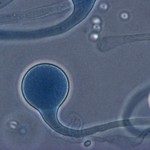Lien vers Pubmed [PMID] – 24548001
Clin. Microbiol. Infect. 2014 Apr;20 Suppl 3:27-46
Mycoses summarized in the hyalohyphomycosis group are heterogeneous, defined by the presence of hyaline (non-dematiaceous) hyphae. The number of organisms implicated in hyalohyphomycosis is increasing and the most clinically important species belong to the genera Fusarium, Scedosporium, Acremonium, Scopulariopsis, Purpureocillium and Paecilomyces. Severely immunocompromised patients are particularly vulnerable to infection, and clinical manifestations range from colonization to chronic localized lesions to acute invasive and/or disseminated diseases. Diagnosis usually requires isolation and identification of the infecting pathogen. A poor prognosis is associated with fusariosis and early therapy of localized disease is important to prevent progression to a more aggressive or disseminated infection. Therapy should include voriconazole and surgical debridement where possible or posaconazole as salvage treatment. Voriconazole represents the first-line treatment of infections due to members of the genus Scedosporium. For Acremonium spp., Scopulariopsis spp., Purpureocillium spp. and Paecilomyces spp. the optimal antifungal treatment has not been established. Management usually consists of surgery and antifungal treatment, depending on the clinical presentation.


